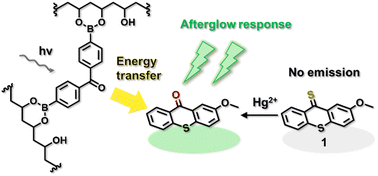Turn-on type afterglow probe for Hg2+ sensing by a PVA-mediated triplet sensitizer†
Abstract
The afterglow phenomenon, which involves lasting emission after ceasing the excitation light, has attracted significant attention as a unique class of luminescence because the related materials can be applied for time-gate bioimaging, background-free chemosensors, data encryption, and other applications. In this context, chemical stimulus afterglow systems have been intriguing targets in this research field. However, this development is at the frontier because introducing a chemical-stimulus acceptable site may facilitate a competitive deactivation process by molecular vibration and oxygen, making it difficult to stabilize the triplet state. Therefore, it remains challenging to develop chemosensing in the afterglow. In this study, benzoylphenyl boronate-crosslinked poly(vinyl alcohol) (PVA) (BPB@PVA) was prepared for the first time to investigate whether the resultant PVA served as a triplet sensitizer. We found that 2-methoxy-9H-thioxanthene-9-thione 1 was doped into the BPB@PVA film, and the resultant film 1/BPB@PVA (1 : 20 : 1000) displayed Hg2+-induced afterglow response with a lifetime of 75.9 ms, accompanied with yellowish green emission after ceasing the irradiation of light at 254 nm. The desulfurization of 1 by Hg2+ in the PVA film produces room-temperature phosphorescence (RTP)-active 2-methoxy-9H-thioxanthen-9-one 2 with the emission quantum yield being increased by the benzophenone-derived cross linkage. We believe that PVA-mediated triplet sensitization is a valid method for functionalizing RTP materials.



 Please wait while we load your content...
Please wait while we load your content...